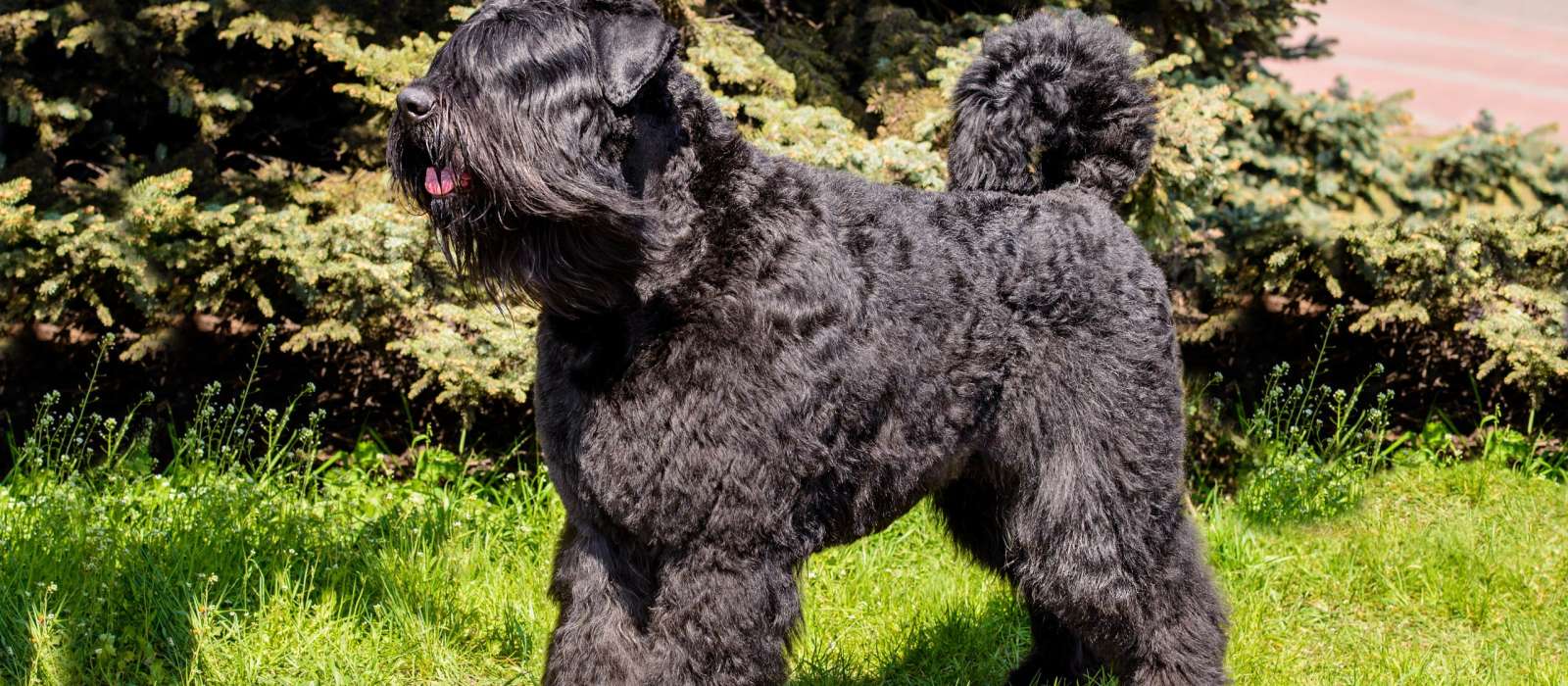-
Activity Level:
high
-
Shedding Level:
low
-
Grooming Level:
moderate
-
Trainability:
high
-
Good for Novice Owners:
moderate
-
Adaptability:
moderate
-
Kid/Pet Friendly:
often
-
Prey Drive:
high
-
Watchdog:
very alert
- Average Size: Large
- Average Lifespan: 10-12 Years
- Registered?: aca, akc
Bouvier des Flandres Dog Breed Information
Overview
Temperament
Adaptability
Health
Owner Experience
Grooming
Activity Level
Size
Life Span
Did You Know?
The Bouvier des Flandres is a working dog that originated in the principality of Flanders during medieval times. The area that was once known as Flanders now spreads across modern-day France, Belgium, and the Netherlands. Because of this, one of the facts about the Bouvier des Flandres is that both France and Belgium claim the Bouvier des Flandres as a native dog breed.
Their name roughly translates to “cowherd of Flanders” and, as their name suggests, they were mostly used for moving cattle. They also have gone by names like Vuilbaard, toucheur de boeuf, and koehond. Although they were primarily cow dogs, Bouvier often served as cart-pullers, guard dogs, watchdogs, and herders.
During World War I, these dogs served as dogs of war for the Belgian army, which could be credited for their survival as a breed. After the war, this dog breed was a popular choice across Europe for serving as police dogs as well as guide dogs. The dog breed brushed up against extinction once again after World War II, but thrived instead courtesy of Europeans who fled with their dogs to the United States. The AKC recognized the Bouvier des Flandres in 1931 as part of the Herding Group.
Today, the Bouvier des Flandres retains their versatility and can still be found working in police and military roles as well as in search and rescue capacities and as service dogs. Plus, they are great family pets for active families who can keep them busy.
This dog breed is known for their intelligence and versatility. Bred to be all-purpose working dogs and watchdogs, the Bouvier des Flandres fits right in with an active family that keeps them involved. They are affectionate towards their families, can have a strong will, and tend to be courageous and outgoing.
Well-socialized, they are a great fit for families as they get along fantastically with children and other dogs. They may look intimidating, but they tend to have a calm and gentle nature. But, they do have a high prey drive, so they will need to be socialized and introduced properly to other smaller pets in the household and tend to do better with those they have been raised with.
The Bouvier is a moderately adaptable dog breed. Because of their high-energy nature and work ethic, they do not tend to do well with apartment living. This dog breed is much better suited to larger homes, especially those with a securely fenced-in backyard where they can run.
They do well in just about any climate and their thick, weatherproof coat serves them well in colder climates. As with any dog breed, they can be sensitive to extreme heat or cold. This dog breed is bored easily, so you will want to keep alone time short and to a minimum, and to make sure they have plenty to keep them mentally stimulated and busy if you have to leave them alone.
The Bouvier des Flandres is a relatively healthy dog breed. As with any dog breed, there are a few potential health conditions to be aware of, which can include glaucoma, myopathy, subaortic stenosis, portosystemic shunt, elbow dysplasia, ectopic ureters, hip dysplasia, hypothyroidism, epilepsy, deafness, laryngeal paralysis, megaesophagus, and cataracts.
Good breeding practices and the health of the parents make a big difference in the health of Bouvier des Flandres puppies. Reputable breeders will screen their dogs to ensure they are not passing preventable issues to puppies.
Asking the breeder about the genetic history of the parents and asking to see any health clearances can help allay concerns about potential health issues. The American Bouvier des Flandres Club, Inc. recommends a cardiac evaluation, an elbow evaluation, a hip evaluation, and an ophthalmologist evaluation.
The Bouvier is also a large, deep-chested dog breed, which puts them at a higher risk of bloat. Bloat in dogs can be serious and quickly becomes fatal if the stomach flips (i.e.; gastric torsion occurs). It’s important to know how to reduce the risk for your dog and to know what symptoms mean it’s time to get to the emergency vet.
This dog breed is highly intelligent, easily picks up on things, and is eager to please. They are highly trainable, but they also have a strong will, which means they can have a stubborn streak and independent nature.
They like to be put to work and require an owner who has the time, space, and experience for the quintessential working dog. This makes them a better fit for more experienced dog owners. First-time or novice dog owners can have success with a Bouvier des Flandres, but will want to enlist the help of a professional trainer and enroll in puppy training classes.
The Bouvier des Flandres is one of the fluffiest dog breeds. They are known for their beard and mustache look. Their coat is practically weatherproof, so they will only need to be bathed as needed and brushed once or twice a week.
You will likely need to check in on their face a few times a week in order to brush and clean their beard and mustache. A pin brush or slicker brush, a large comb, and a small comb for the beard and mustache are good dog grooming brushes to have on hand.
In addition to coat care, you will also need to care for your Bouvier des Flandres’s nails, ears, and teeth. Usually, trimming your dog’s nails once or twice monthly is sufficient. For this dog breed, you will want to check their paws every week or two and trim or file nails as needed. You will also want to regularly check and carefully clean their ears as needed. It’s important to make sure your dog’s ears are dry, clean, and free of debris to help prevent ear infections.
Proper dental care for dogs is also essential to prevent dental diseases like gum disease and tooth decay later in life. Using an enzyme toothpaste or brushing your dog’s teeth every day, in addition to cleanings at the vet when needed, is one of the best ways to help prevent dental disease in your dog. Dental hygiene chews, dental treats, a special dental care diet, and more are all ways you can supplement your basic doggie dental care plan.
It’s usually a good idea to get your dog used to having their paws, ears, and mouth handled as a puppy and to keep it a rewarding experience. Not only does this make grooming throughout your dog’s life a much easier process for you both, but it can also help build a bond with your dog and make grooming a bonding experience that you both look forward to!
The Bouvier is a high-energy working dog with a strong work ethic. They need a job to do and need to stay busy in order to be happy. Thankfully, they are also a very versatile working dog that can take on almost anything.
They fit right in on a farm or ranch, are wonderful guard dogs and watchdogs, and also are a great candidate for dog sports. As part of the Herding Group, they tend to excel at herding trials. They also tend to be a good fit for agility training, carting, tracking, obedience, and other canine sporting events. A Bouvier will also often enjoy joining you on hikes, runs, biking trips, trips to the dog park, and even swimming.
You will want to keep exercise low-impact while your Bouvier des Flandres is still a puppy. Their bones and muscles are still developing, so too much heavy exercise or high-impact activities can damage their developing joints. These dogs do make great running or biking partners; just save it for when they’ve finished growing and have been cleared by the vet for higher-impact activities.
A fully-grown Bouvier des Flandres usually stands 23.5-27.5 inches tall at the shoulder and weighs 70-110 pounds.
Bouvier des Flandres generally live for 10-12 years on average.
The Bouvier has been a presidential pup! President Ronald Reagan and First Lady Nancy Reagan owned a Bouvier des Flandres named Lucky.






